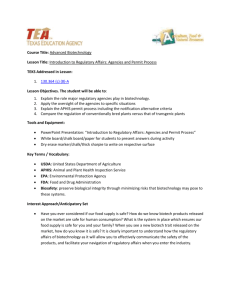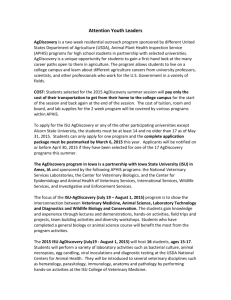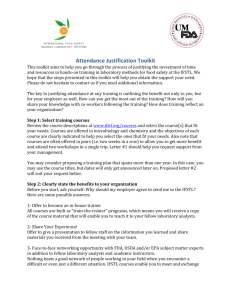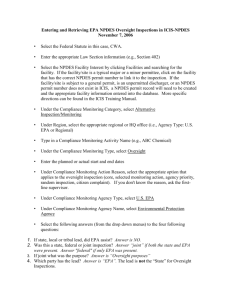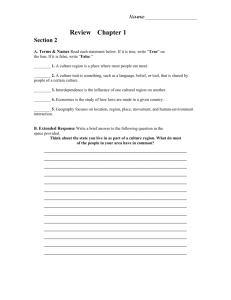Advanced Biotechnology - Educational Excellence
advertisement
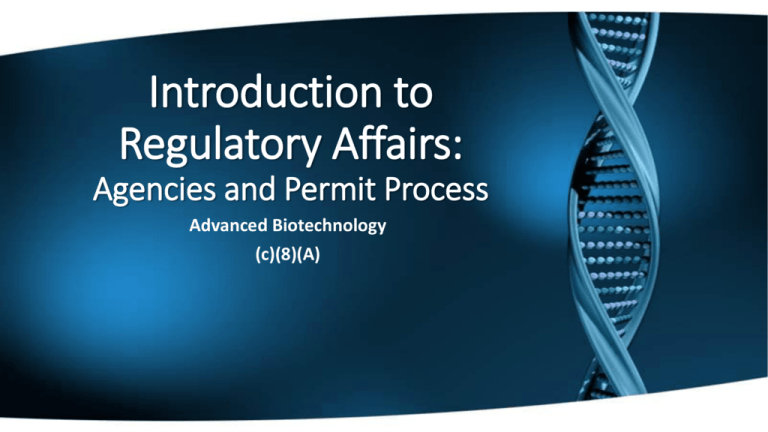
Introduction to Regulatory Affairs: Agencies and Permit Process Advanced Biotechnology (c)(8)(A) Objectives Today you will be able to: • Explain the role major regulatory agencies play in biotechnology • Apply the roles of the agencies to regulating specific biotech products • Explain the APHIS permit process including the notification alternative criteria Biosafety: Upmost Importance • Biosafety: Preserve biological integrity through minimizing risks that biotechnology may pose to these systems. • Regulatory systems in place help achieve this. Major Players in Regulation • Federal: • U.S. Department of Agriculture (USDA) • Animal and Plant Health Inspection Service (APHIS) • Environmental Protection Agency (EPA) • Food and Drug Administration (FDA) • State: • States can regulate as they see fit. • Example: • Florida requires a permit for the release of genetically modified organisms. Agency Regulatory Oversight USDA EPA FDA Food Plants Microbial & plant pesticides Feed Plant Pests New uses of existing pesticides Food Additives Veterinary Biologics Novel microorganisms Drugs Medical Devices Agency Oversight Activity • Split up into groups of three to four • You will need a writing surface to present answers • When I ask for answers, hold up your answer. • If you answer correctly, you win a point. • Group with the highest number of points wins Agency Oversight Activity Which agencies will review this product? You engineered a sweet corn trait that is resistant to maize dwarf mosaic virus (MDMV). Which agencies need to review your product, and for what purpose? Agency Oversight Activity Which agencies will review this product? You engineered a sweet corn trait that is resistant to maize dwarf mosaic virus (MDMV). Which agencies need to review your product, and for what purpose? USDA (is it safe to grow?) EPA (is it safe for the environment?) FDA (is it safe to eat?) Agency Oversight Activity Which agencies will review this product? You engineered a soybean trait that is resistant to glufosinate herbicide. Which agencies need to review your product, and for what purpose? Agency Oversight Activity Which agencies will review this product? You engineered a soybean trait that is resistant to glufosinate herbicide. Which agencies need to review your product, and for what purpose? USDA (is it safe to grow?) EPA (New use of companion herbicide) FDA (is it safe to eat?) Agency Oversight Activity Which agencies will review this product? You engineered a pine tree trait that is resistant to glyphosate herbicide. Which agencies need to review your product, and for what purpose? Agency Oversight Activity Which agencies will review this product? You engineered a pine tree trait that is resistant to glyphosate herbicide. Which agencies need to review your product, and for what purpose? USDA (is it safe to grow?) EPA (New use of companion herbicide) Agency Oversight Activity Which agencies will review this product? You engineered a canola trait which produces a higher content of Vitamin E in the oil. Which agencies need to review your product, and for what purpose? Agency Oversight Activity Which agencies will review this product? You engineered a canola trait which produces a higher content of Vitamin E in the oil. Which agencies need to review your product, and for what purpose? USDA (is it safe to grow?) FDA (is it safe to eat?) Agency Oversight Activity Which agencies will review this product? You engineered a trait in rose plants which produces bright blue color. Which agencies need to review this product, and for what purpose? Agency Oversight Activity Which agencies will review this product? You engineered a trait in rose plants which produces bright blue color. Which agencies need to review this product, and for what purpose? USDA (is it safe to grow?) Agency Oversight Activity Which agencies will review this product? You engineered a soil bacteria which breaks down dioxins. Which agencies need to review this product, and for what purpose? Agency Oversight Activity Which agencies will review this product? You engineered a soil bacteria which breaks down dioxins. Which agencies need to review this product, and for what purpose? EPA (is it safe for the environment?) APHIS • Animal and Plant Health Inspection Service • Agency of the USDA • Permit system with a notification alternative • Must obtain permit, unless a notification or exemption applies, before moving or releasing a genetically engineered plant. APHIS Permits • 3 types of permits: • Permit for Movement and Importation • Permit for Release into the Environment • Courtesy Permit • Before plant material can be sold, you must petition for USDA exemption from regulation. Once done, you no longer require permits for release or movement. APHIS Permit Alternatives • Process used for importation, interstate movement, and field testing of certain engineered organisms. • Instead of applying for a permit, you can notify APHIS that a movement or release is planned. • However, your plant must meet eligibility requirements and follow performance standards for release. • Why would you prefer this over a permit? APHIS Notification Eligibility Criteria • Plant must not be listed as a Federal Noxious Weed, or considered a weed in the geographic area of release • Genetic material must be stably integrated. DNA cannot exist outside the cell, and must replicate exclusively with plant DNA • The function of the trait added is known, and does not result in plant disease APHIS Notification Eligibility Criteria • The trait added does NOT: • Produce an infectious entity • Produce known or likely toxins to non-target organisms • Produce products intended for pharmaceutical or industrial use • Genetic sequences derived from plant viruses do not pose a significant risk to the creation of new plant viruses. • The plant has not been modified to contain certain genetic material derived from an animal or human pathogen, nor use sequences which products are known agents of disease in humans or non-target animals APHIS Notification Performance Standards • Must be shipped and maintained so there is no release in environment. There cannot be regulated and nonregulated mixing. • Identity of all material must be known. At the conclusion of tests, plant material must be contained or devitalized. APHIS Notification Performance Standards • If transformation uses a live microorganism, the plant must be free of microorganism prior to movement or release. • The regulated material and offspring cannot persist in the environment • No viable plant material should remain that can germinate and create volunteers. Volunteers must be destroyed. APHIS Petition Process • Petition Process: request that a regulated plant should no longer be regulated • This must always be done before commercialization of the transformed material. • APHIS will grant non-regulated status to a new plant variety when it determines that this variety has no potential to pose a plant pest risks, and is safe to grow. Environmental Protection Agency • Ensures safety of pesticides • Chemical and biological • EPA sets tolerance limits for pesticides on and in food/feed, or develops an exemption from this tolerance requirement • Develops tolerances for residues of herbicides used on novel herbicide-tolerant crops Food and Drug Administration • Requires that genetically modified food meet same rigorous safety standards as other food. • Three FDA Categories: • Whole Foods – no changes in nutritional profile, no substance that may pose health hazards • Food Additives – significantly different in structure, function or amount than in current food. Must receive pre-commercialization approval. • Generally recognized as safe (GRAS) – consumed for long periods without hazards. Scientifically found to have no undesirable effects on humans. Product is generally the same as if it would be in nature. Food and Drug Administration • What Makes a Product Safe? Not from a source with a history of toxicity or allergy Does not resemble known toxins or allergens Well understood functions Gene expression is at low levels Rapidly degraded in the stomach Lack of adverse effects in mice at high levels of consumption Animal feeding studies do not revel adverse effects. Difference in Regulatory Processes Transgenic Plant Conventionally Bred Plant • Product characterization • Toxicity/Allergenicity • Crop safety • Food composition • Environmental safety Product can be removed by USDA, FDA, or EPA if there is a question of safety for the environment or consumers. No Mandatory Testing Product can be removed by USDA, FDA, or EPA if there is a question of safety for the environment or consumers. Summary • Fundamentally, biotech regulations serve to uphold biosafety. • USDA, FDA, EPA all play important roles in regulating applications of biotechnology • APHIS has a permit process, and a notification alternative under specific criteria • Transgenic plants are studied to ensure safety for all systems it may come in contact with Evaluation • What role do the regulatory agencies play in biotechnology? • What purpose does the APHIS permit serve? • What is the notification alternative? • What is the criteria to use the notification alternative? • What purpose does deregulation serve? • How does the regulatory process differ between a transgenic plant and a conventionally bred one?
